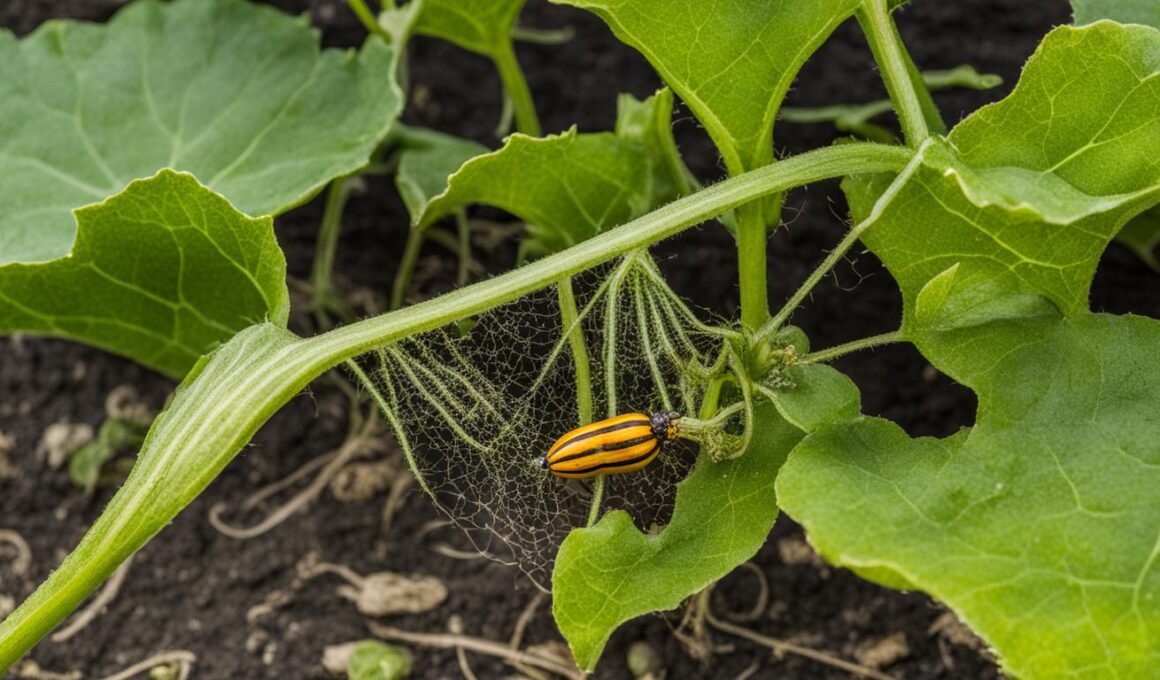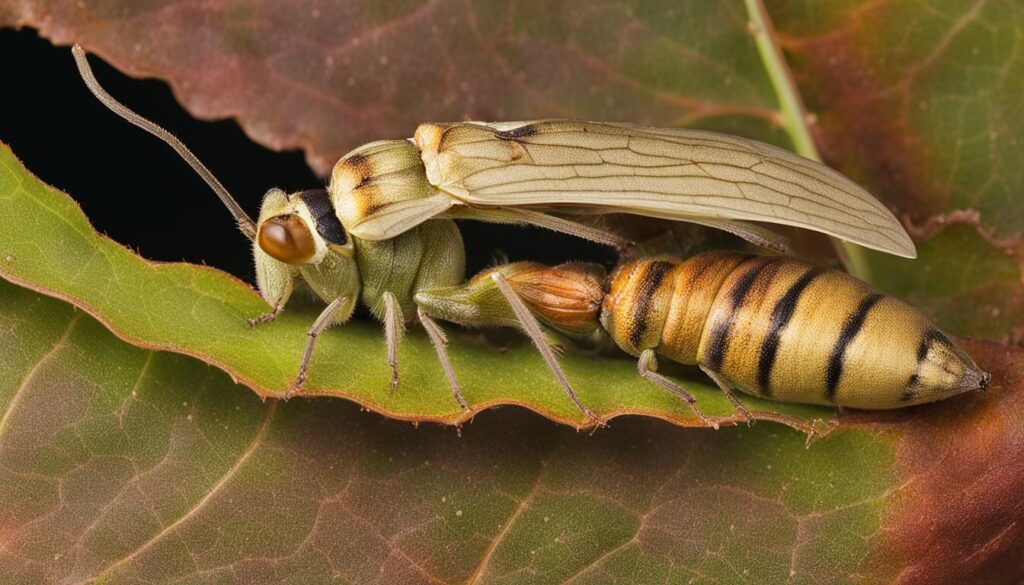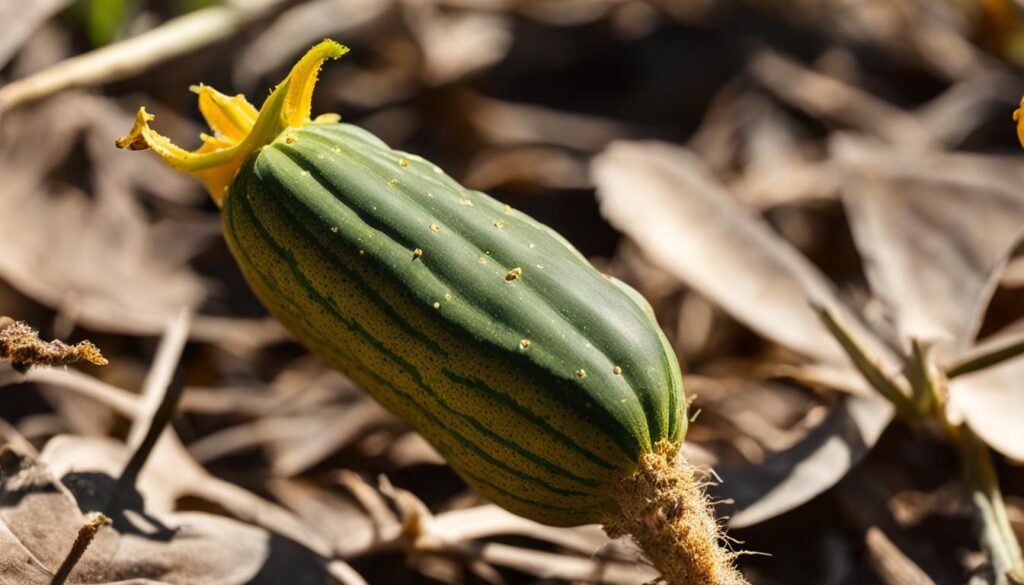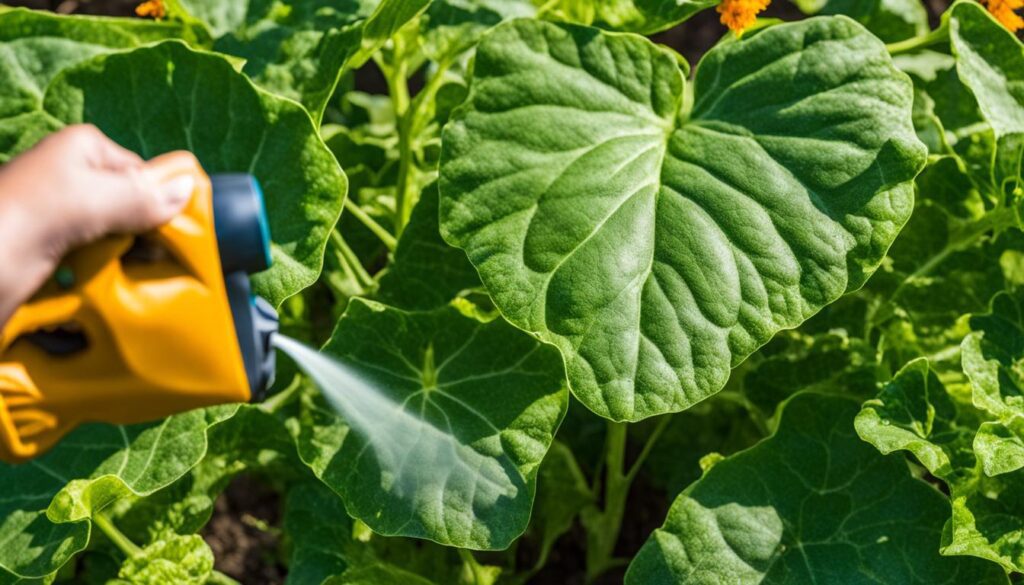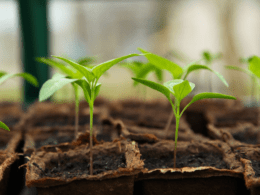In this article, we will provide you with effective tips for controlling squash vine borers using organic methods. These tips will help you prevent squash vine borer infestations and protect your squash plants.
Key Takeaways:
- Prevent squash vine borer infestations with organic methods
- Use Bt spray to control squash vine borers
- Mulch the stems of squash plants to deter egg-laying
- Consider planting resistant squash varieties
- Manual removal and insecticides can help get rid of existing infestations
What are Squash Vine Borers?
Squash vine borers are the larvae of an orange and black sesiid moth. They are diurnal and often mistaken for wasps due to their appearance. These moths lay their tiny, copper-colored eggs on squash plants, which then hatch into larvae. The larvae chew their way inside the plant’s stem and feed on the plant, causing damage and eventual death. A single adult female squash vine borer moth can lay up to 150 eggs in a season.
These pests are commonly found in various squash plant varieties and can be a significant threat to your garden. Squash vine borers are considered a major squash plant pest due to the damage they cause. Once inside the stem, the larvae disrupt the flow of water and nutrients, causing wilting and eventually killing the plant.
To effectively control squash vine borers, it’s important to understand their life cycle and the signs of infestation. By being aware of their presence and taking preventative measures, you can protect your squash plants and minimize the damage caused by these pests.
How to Identify Squash Vine Borers?
If you want to effectively control squash vine borers, it is crucial to be able to identify the signs of their presence in your squash plants. By recognizing these signs early on, you can take the necessary steps to prevent further damage and protect your plants.
One of the most noticeable signs of a squash vine borer infestation is sudden wilting of the squash plant. If you notice that your squash plant is wilting rapidly, especially during the hottest part of the day, it could be a clear indication of squash vine borer activity.
Another telltale sign is holes in the stems of the plant. Squash vine borer larvae chew their way inside the stem and feed on the plant’s tissues, which weakens the stem and restricts the flow of nutrients. These holes are often accompanied by frass, which is a granular substance that consists of the chewed-up stem material. Frass can be found around the openings of the stems and serves as a clear indicator of squash vine borer presence.
In conclusion, being able to identify the signs of squash vine borers in your squash plants is essential for prompt and effective control. Look out for sudden wilting, holes in the stems, and frass around stem openings. By staying vigilant and taking appropriate action, you can minimize the damage caused by these pests and ensure the health and productivity of your squash plants.
Preventing Squash Vine Borers with Bt Spray
If you’re looking for an effective and organic method to control squash vine borers, consider using Bt spray. Bt, which stands for Bacillus thuringiensis, is a natural bacteria that specifically targets and kills the larvae of squash vine borers. This means you can protect your squash plants without resorting to harmful chemicals.
To use Bt spray effectively, it’s important to choose a product that contains the strain Bacillus thuringiensis var. kurstaki (Btk), as this strain is specifically formulated to control squash vine borers. Apply the spray to all parts of the squash plant, including the leaves, leaf stems, and main stem where the adult moths lay their eggs. For optimal protection, it’s recommended to spray twice per week and after rain storms.
“Bt spray is an effective and safe option for controlling squash vine borers. It’s designed to only affect the larvae of these pests, so you don’t have to worry about harming beneficial insects or other wildlife in your garden.”
Using Bt spray as part of your pest management strategy can help prevent squash vine borer infestations and keep your squash plants healthy and productive. Not only is it an organic control method, but it also ensures the safety of other garden-friendly insects. Incorporate Bt spray into your routine and enjoy a thriving squash harvest.
Key Points:
- Bt spray is an organic and effective method for controlling squash vine borers.
- Choose a Bt spray product that contains Bacillus thuringiensis var. kurstaki (Btk) for optimal results.
- Apply the spray to all parts of the squash plant, including leaves, leaf stems, and the main stem.
- Spray twice per week and after rain storms for maximum protection.
Mulching the Squash Plant’s Stems
Mulching the stems of your squash plants is an effective method for preventing squash vine borer infestations. By covering the main stem with mulch, you create a physical barrier that prevents adult moths from laying their eggs directly on the stems. This simple and organic technique can significantly reduce the risk of squash vine borer damage.
When mulching your squash plants, use organic materials such as straw, wood chips, or compost. Start by clearing the area around the plants, removing any weeds or debris. Then, apply a layer of mulch around the base of the stem, making sure to cover it completely. The mulch should extend several inches away from the stem to create a wide enough barrier.
Mulching not only acts as a deterrent for squash vine borers but also provides additional benefits for your plants. It helps retain moisture in the soil, suppresses weed growth, and keeps the soil temperature more stable. Additionally, mulching promotes vining and crawling varieties to set new roots along their stems, allowing the plant to continue supporting new growth even if it has been attacked by squash vine borers.
Benefits of mulching for squash vine borer prevention:
- Creates a physical barrier against adult moths
- Reduces the risk of squash vine borer infestation
- Retains moisture in the soil
- Suppresses weed growth
- Stabilizes soil temperature
- Promotes new root growth for damaged plants
“Mulching the stems of your squash plants is a simple yet effective way to protect them from squash vine borers. By creating a physical barrier with mulch, you can prevent the moths from laying their eggs directly on the stems, reducing the likelihood of infestation. It’s a natural and organic method that also benefits your plants by retaining moisture and suppressing weeds. Give your squash plants a fighting chance against squash vine borers with this preventative technique.”
By implementing mulching as part of your squash vine borer prevention strategy, you can protect your plants and increase your chances of a healthy harvest. Along with other organic methods such as Bt spray and physical barriers, mulching provides a comprehensive approach to controlling squash vine borers. Remember to regularly monitor your plants for any signs of infestation and take prompt action if needed. With the right prevention measures in place, you can enjoy a bountiful harvest of delicious squash throughout the season.
Using Physical Barriers and Resistant Varieties
When it comes to preventing squash vine borer infestations, physical barriers and resistant squash varieties can be valuable tools in your arsenal. By incorporating these prevention methods into your gardening routine, you can significantly reduce the risk of squash vine borers damaging your plants.
One effective approach is the use of physical barriers, such as strips of nylon stockings or aluminum foil. These barriers can be wrapped around the stems of your squash plants, creating a barrier that deters adult moths from laying their eggs. By blocking their access to the stems, you can prevent the larvae from burrowing inside and causing damage.
“The use of physical barriers, such as strips of nylon stockings or aluminum foil, can be an effective way to prevent squash vine borers from attacking your plants.”
Another strategy is to plant resistant squash varieties that are less susceptible to squash vine borer attacks. Butternut squash and Cucuzzi are known to have some resistance to these pests. By selecting these varieties, you can minimize the risk of infestations and increase the chances of a successful harvest.
Remember, incorporating physical barriers and resistant squash varieties is just one part of a comprehensive prevention plan. It’s also important to practice good garden hygiene by removing any plant debris or spent vines at the end of the growing season. This helps eliminate potential hiding spots for squash vine borers and reduces the chances of future infestations.
Key Points:
- Use physical barriers like strips of nylon stockings or aluminum foil to deter squash vine borer egg-laying.
- Plant resistant squash varieties, such as butternut squash or Cucuzzi, to reduce the risk of infestations.
- Practice good garden hygiene by removing plant debris and spent vines at the end of the season.
Getting Rid of Squash Vine Borers
If you already have squash vine borers in your plants, don’t worry, there are methods to get rid of them or minimize their damage. Here are some effective strategies:
- Manual removal: One way to combat squash vine borers is by manually removing them from the stems. Carefully cut the affected area of the stem and remove the larvae. This method can be time-consuming, but it can significantly reduce the population of borers in your plants.
- Insecticides: Another option is to use insecticides specifically formulated to control squash vine borers. Look for products containing carbaryl, permethrin, or esfenvalerate, which are known to be effective against these pests. However, timing is crucial for the success of insecticide application. Apply them when the larvae are hatching for the best results.
By utilizing these methods, you can effectively eliminate squash vine borers and protect your plants from further damage.
Tip: Remember to always follow the instructions and safety precautions mentioned on the insecticide labels. Wear appropriate protective gear and avoid using chemical treatments excessively to minimize any potential harm to the environment or beneficial insects.
Keep in mind that prevention is key when it comes to dealing with squash vine borers. By implementing organic control methods, such as using Bt spray, mulching the stems, and planting resistant squash varieties, you can reduce the risk of infestation and ensure the health of your squash plants.
Summary:
If you find squash vine borers in your plants, there are several effective ways to get rid of them and minimize their damage. Manual removal involves cutting out the affected area and removing the larvae. Insecticides containing carbaryl, permethrin, or esfenvalerate can also be used, but timing is critical. Always follow the instructions and safety precautions when using insecticides. Prevention is essential, so consider using organic methods like Bt spray, mulching the stems, and planting resistant squash varieties to reduce the risk of infestation and protect your squash plants.
Conclusion
Controlling squash vine borers and protecting your squash plants is crucial for a successful harvest. By implementing these organic methods and prevention strategies, you can effectively manage squash vine borer infestations.
Using Bt spray, which contains the natural bacteria Bacillus thuringiensis, is a safe and effective way to control squash vine borers. Regularly applying the spray to all parts of the plant can prevent the larvae from causing damage.
Additionally, using physical barriers like strips of nylon stockings or aluminum foil can deter adult moths from laying their eggs on the stems of your squash plants. This simple method can help minimize the risk of squash vine borer infestation.
Furthermore, planting resistant varieties of squash, such as butternut squash or Cucuzzi, can provide an additional layer of protection. These varieties are less susceptible to squash vine borer attacks and can withstand some damage.
By combining these organic methods and prevention strategies, you can control squash vine borers and ensure a healthy and productive squash harvest.
What Are Some Effective Methods for Controlling Squash Vine Borers?
One of the efficient tips to stop vine borers is to implement proper crop rotation. By avoiding planting squash or related plants in the same area year after year, you disrupt the life cycle of vine borers, decreasing their population. Additionally, regularly inspect the plants for eggs or larvae and remove them promptly to prevent further infestation. Applying insecticides and covering the base of stems with aluminum foil can also be helpful in controlling squash vine borers.
FAQ
What are squash vine borers?
Squash vine borers are the larvae of an orange and black sesiid moth. They are diurnal and often mistaken for wasps due to their appearance. These moths lay their tiny, copper-colored eggs on squash plants, which then hatch into larvae. The larvae chew their way inside the plant’s stem and feed on the plant, causing damage and eventual death.
How can I identify squash vine borers?
Signs of a squash vine borer infestation include sudden wilting of squash plants, holes in the stems, and frass (chewed-up stem material) around the openings. If you notice these signs in your squash plants, it is likely that they have been attacked by squash vine borers.
How can I prevent squash vine borers using organic methods?
Bt (Bacillus thuringiensis) spray is an effective organic method for controlling squash vine borers. Apply Bt spray to all parts of the squash plant, including leaves, leaf stems, and the main stem where eggs are often laid. Mulching the stems of squash plants and using physical barriers, such as nylon stockings or aluminum foil, can also help prevent squash vine borer infestations. Additionally, planting resistant squash varieties can minimize the risk of infestation.
How can I get rid of squash vine borers?
If you already have squash vine borers in your plants, you can manually remove the borers from the stems by carefully cutting the affected area and removing the larvae. Insecticides containing carbaryl, permethrin, or esfenvalerate can also be used to control squash vine borers, but timing is critical for their effectiveness. Applying them when larvae are hatching is crucial for success.
What should I do to control squash vine borers and protect my squash plants?
Controlling squash vine borers is essential for a successful squash harvest. By following effective tips such as using organic methods like Bt spray, mulching the stems of squash plants, using physical barriers, and planting resistant varieties, you can prevent and manage squash vine borer infestations. Additionally, practicing good garden hygiene can help minimize the risk.





